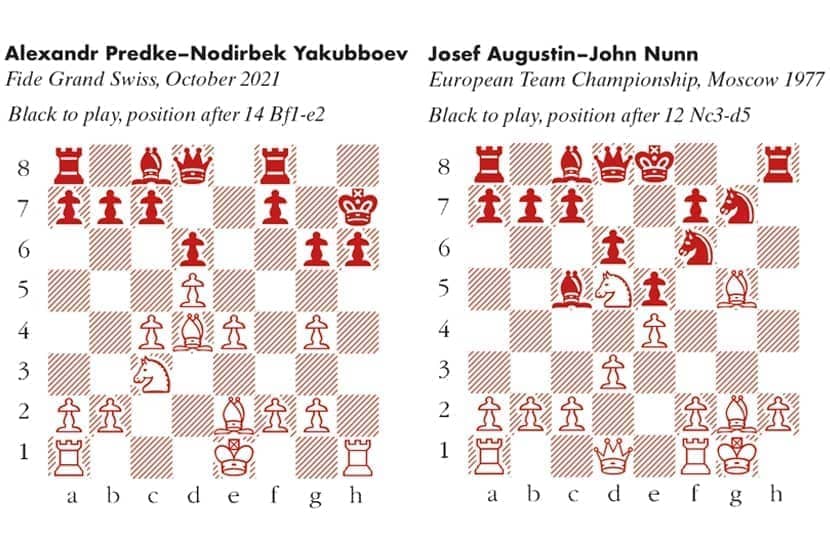One of the most eye-catching games from the recently concluded Fide Grand Swiss in Riga saw an early sacrifice of queen for knight, bishop and pawn. This exotic balance of material usually favours the queen, based on the rule of thumb that pawn = 1, knight = 3, bishop = 3, rook = 5, queen = 9. But when the minor pieces coordinate well, particularly with rooks alongside, they can be more than a match for the queen.
A queen’s greatest strength is her ability to attack, and perhaps fork, any pieces that are not nailed down. So when you jettison your queen for a miscellany of pieces, they had better resemble a florentine more than a fruit salad. It helps when the minor pieces have a clear target of their own.
That is the situation that occurred after 14 Be2 (see diagram 1). Black’s problem was that he had nothing to attack, and 14…Qg5 15 Be3 would only make things worse. 14…f5 was a bid to open up lines for the queen, but after Predke’s accurate response, it was Black’s king that came under fire.
Alexandr Predke–Nodirbek Yakubboev
Fide Grand Swiss, October 2021
1 d4 Nf6 2 c4 g6 3 Nc3 Bg7 4 e4 d6 5 h3 O-O 6 Bg5 Nc6 7 Nf3 h6 8 Be3 e5 9 d5 Nd4 10 Nxd4 exd4 11 Qxd4! 11 Bxd4 allows a powerful riposte: Nxe4! Then 12 Nxe4 (or 12 Bxg7 Re8!) Qh4! wins back the piece. One pretty idea is 13 g4 Re8 14 Bg2 Bf5! 15 gxf5 Rxe4+ Ng4 12 hxg4! 12 Qd2 Nxe3 13 Qxe3 grants Black good compensation on the dark squares. Bxd4 13 Bxd4 Kh7 14 Be2 (see diagram 1 ) f5 15 exf5 gxf5 16 Rh5 Kg6 16…fxg4 17 Bd3+ is devastating 17 Kd2 fxg4 18 Rah1 Bf5 19 Rxh6+ Kf7 20 R1h5 Ke7 21 Nd1 After this elegant regrouping, the knight will be nicely anchored on e3, and the Bf5 is unmoored. c5 22 Bc3 Kd7 23 Ne3 Bb1 24 Bxg4+ Kc7 25 f3 Qe8 25…Bxa2 allows the rook in to h7: 26 Ba5+ b6 27 Rh7+ Kb8 28 Bc3 and Rh7-d7 is looming 26 Rh1 Bg6 27 Re1 Rg8 28 Be6 Qf8 29 Reh1 Re8 30 R1h4 Preparing 31 Bxg8 Qxg8 32 Rg4. Rxe6 31 dxe6 Qe8 32 Nd5+ Kc6 33 Nf6 Qe7 34 Rg4 Black resigns
Predke’s sacrifice reminded me of a beautiful game played by England’s John Nunn in 1977. In the diagram position, 12…Ngh5 13 Nxf6+ Nxf6 14 Qf3 would recover the piece. Instead, Nunn dealt with the pin in a more radical fashion.
Josef Augustin–John Nunn
European Team Championship, Moscow 1977
12… Nxd5 13 Bxd8 Nf4 14 Bg5 Nge6 15 Bxf4 Nxf4 White has no way to budge this mighty knight, and is soon overrun on the kingside. 16 Kh1 Be6 17 Bf3 Rh4 18 Rg1 Ke7 19 Rg2 Nxg2 20 Bxg2 Rah8 21 Qd2 Rxh2+ 22 Kg1 R2h4 23 Re1 Rg8 24 Re3 Bxe3 25 Qxe3 Bh3 26 Kf1 Bxg2+ 27 Ke2 c5 28 Qd2 b6 29 Qc3 Rgg4 30 Qa3 a5 31 Qb3 Bh3 32 f3 Rg2+ 33 Ke3 Bg4 34 fxg4 Rfxg4 and R4g3 mate. White resigns






Comments